2011 Industry Outlook: Optimism shines
Materials handling industry experts report that 2010 was better than expected and believe that we’re painting a brighter picture for 2011.
After three years of hoping for economic bright spots to report in Modern’s annual Industry Outlook, it looks like there’s finally more bloom than gloom. While we’re not back to pre-recession numbers yet, materials handling industry experts across the board are reporting growth in 2010 and expect it to continue in 2011 and 2012.
That positive feedback tracks with the nation’s overall economic news. In the first quarter of 2010, the U.S. Gross Domestic Product (GDP) grew 3.7%. In the second quarter it grew 1.7%, and in the third it was up 2.6%. With the GDP expected to rise over the next two years, it appears the upward trend will continue. For instance, Jan Hatzius, chief U.S. economist for Goldman Sachs, is predicting the United States can expect substantial acceleration in real GDP growth over the next two years to a 4% pace by early to mid 2012.
In the materials handling sector, increased demand is apparent as the economy shifts from recession to recovery, according to Hal Vandiver, executive consultant for the Material Handling Industry of America. Filling supply chain pipelines, re-establishing inventories, and responding to pent up demand has been the principal impetus for improvement over the last few quarters in manufacturing, warehousing and distribution, he says.
SAVE THIS IMPORTANT WEBCAST DATE | Thursday, March 31, 2011 | 1:00 p.m. EST
Join Group Editorial Director Michael Levans, Executive Editor Bob Trebilcock, and materials handling equipment consultant Don Derewecki as they go deeper into the data gleaned form the 2011 survey results while tracking changes in the material handling market over the past year.
Modern’s industry survey results
Modern readers are also feeling positive, according to our recent 2011 State of the Industry study. The annual survey, which was e-mailed to Modern readers in January, tracks market changes during the last year and is designed to clarify the current state, trends and practices in manufacturing, warehousing and distribution.
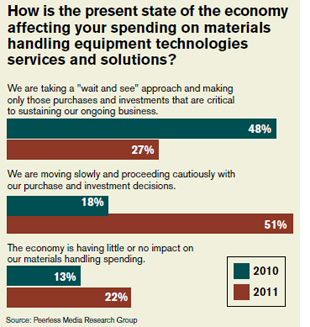 This year’s survey yielded 463 qualified respondents. As a whole, respondents were more optimistic about the future than they were a year ago. More than half (51%) report they are moving forward with needed and planned purchases and investments. About half (47%) expect 2011 spending to be on par with 2010, and 36% expect that it will increase. A modest 27% say they are limiting purchases to things that are critical to sustaining ongoing business, and 22% say that current economic conditions are not impacting their materials handling spending.
This year’s survey yielded 463 qualified respondents. As a whole, respondents were more optimistic about the future than they were a year ago. More than half (51%) report they are moving forward with needed and planned purchases and investments. About half (47%) expect 2011 spending to be on par with 2010, and 36% expect that it will increase. A modest 27% say they are limiting purchases to things that are critical to sustaining ongoing business, and 22% say that current economic conditions are not impacting their materials handling spending.
The outlook for 2012 is even more encouraging. Only 8% of respondents expect next year’s spending to be less than this year, while 45% expect to increase spending more than 5%. And, over the course of the next 18 months, one out of four companies expect to spend more than $250,000 on materials handling solutions.
MHIA overview
The numbers back up the feeling of optimism. Comparing MHIA’s expectations for last year to actual results, MHIA CEO John Nofsinger says, “In some cases, we came back quicker than expected.”
For example, Nofsinger expected shipments to grow by 1% to 2% in 2010, when, in fact, they grew about 7%. Exports, which he expected to climb from $3.7 billion to $3.8 billion, actually increased about 25% up to $4.3 billion. Imports grew by 11%, which was also higher than expected.
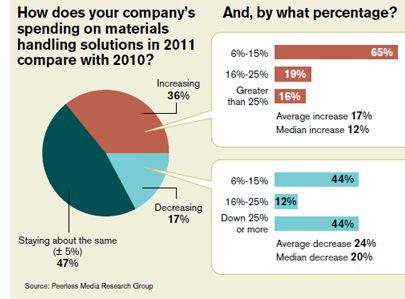 Looking forward into 2011, the Material Handling Equipment Manufacturing (MHEM) forecast, conducted by MHIA, supports Nofsinger’s expectations for an 11% to 12% increase across the board for orders, shipments, imports and exports.
Looking forward into 2011, the Material Handling Equipment Manufacturing (MHEM) forecast, conducted by MHIA, supports Nofsinger’s expectations for an 11% to 12% increase across the board for orders, shipments, imports and exports.
What’s more, in a survey of industry leadership, Nofsinger says all signs are pointing toward underlying optimism end-to-end. “Numbers aside, there’s confidence,” Nofsinger says. “What everyone is talking about supports low double-digit growth.”
Nofsinger also believes there will be targeted investments, with disproportionate shares going toward IT and solutions that better integrate processes. “Companies will pick their battles carefully and choose wisely when they decide to release money,” he says.
On the global materials handling front, Asia and developing countries are doing somewhat better, Europe has stabilized, and Germany has come back a little stronger than predicted. As far as improvement in the developing world, Nofsinger says it’s growing, but he’s not predicting double-digit growth.
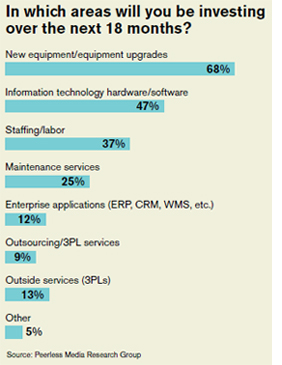 Lift trucks picking up
Lift trucks picking up
Here at home, the lift truck market experienced double-digit growth in 2010 and is picking up faster than expected in 2011. Last year, Jeff Rufener, president of the Industrial Truck Association and vice president of marketing for Mitsubishi Caterpillar Forklift America, said 2010 was going to be a recovery year and was looking for the lift truck industry to grow by about 7%.
The good news is his number was off. Rufener reports the North American lift truck market outpaced last year’s 7% prediction substantially and actually grew by 39%. Breaking it down, electric lift truck sales grew by 32% and internal combustion (IC) sales grew by 52%. These numbers are especially important because Rufener said that single-digit growth would not provide a lot of relief from the financial strain that the industry was under at that time.
More good news: Rufener was concerned that the tight credit market would be an issue in 2010. Credit was no more of an issue in the lift truck business than in any other business, he says, and doesn’t expect it to be a problem this year either.
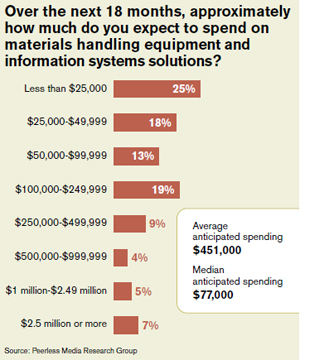 What Rufener does expect is more growth. “I expect to see a little more growth in IC as the economy continues to recover,” he says. “I don’t expect the electric segment of the market, which is currently at 63%, to ever fall below 60% because we’re dealing with more profound issues like the cost of fossil fuel, government regulation and more concern about environment. These issues are here to stay, and the impact they have on the market is causing the lasting shift we’re seeing.”
What Rufener does expect is more growth. “I expect to see a little more growth in IC as the economy continues to recover,” he says. “I don’t expect the electric segment of the market, which is currently at 63%, to ever fall below 60% because we’re dealing with more profound issues like the cost of fossil fuel, government regulation and more concern about environment. These issues are here to stay, and the impact they have on the market is causing the lasting shift we’re seeing.”
That said, Rufener reports that ITA members are looking for overall lift truck industry growth of 10% over 2010 and another 10% for 2012.
Automatic identification and data capture
The automatic identification and data capture (AIDC) sector is also on the rise. Tom Wimmer, director of auto ID and transaction automation practice at Venture Development Corp., reported last year that AIDC took a hit when then economy declined, but he still believed in near-term growth opportunities in 2010. Was he right?
SAVE THIS IMPORTANT WEBCAST DATE | Thursday, March 31, 2011 | 1:00 p.m. EST
Join Group Editorial Director Michael Levans, Executive Editor Bob Trebilcock, and materials handling equipment consultant Don Derewecki as they go deeper into the data gleaned form the 2011 survey results while tracking changes in the material handling market over the past year.
“What a difference a year makes,” says Wimmer. “Many of the bar code and RFID suppliers we track are rebounding faster than expected. We talked to suppliers in first half of 2010 and saw unprecedented growth that exceeded our expectations. Suppliers got a nice bump in first half of 2010, and it continued throughout the year.”
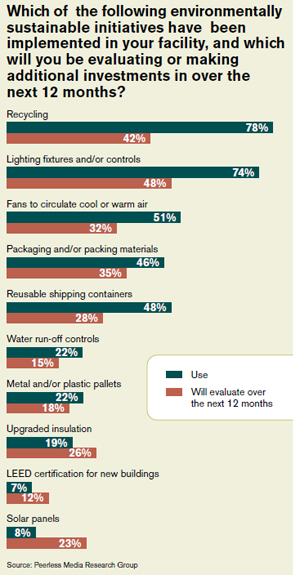 Growth, which was in the mid teens, could be attributed in part to two factors. “Suppliers are restocking depleted inventory and projects that were put on hold in 2009 were green-lighted again,” Wimmer says.
Growth, which was in the mid teens, could be attributed in part to two factors. “Suppliers are restocking depleted inventory and projects that were put on hold in 2009 were green-lighted again,” Wimmer says.
Specifically, on the printing side of AIDC technology, recovery was prevalent across the board. Mobile printing was the fastest growing segment and consumables, such as drums, toner and receipts, grew 6% last year. Wimmer calls consumables “a steady product that doesn’t fluctuate dramatically” and anticipates another year of 6% growth.
The RFID segment grew throughout recession, and is expected to continue that growth moving forward. Wimmer says he has data suggesting that bar code and RFID users are moving beyond their pilot phases and increasing budget allocations for 2011.
The trend in multi-modal data capture—combining bar code, RFID and voice technologies to provide benefits throughout the entire supply chain—is also expected to remain on a growth course through 2011 and beyond.
Overall, Wimmer anticipates a “nice lift in 2011, with a return to an historic growth rate of 4% to 7% from most of technologies including RFID, scanning and mobile printing.”
Software market not as soft
In the supply chain management software arena, which includes network design and supply chain planning (SCP), warehouse management systems (WMS), manufacturing execution systems (MES), and transportation management systems (TMS), expectations were for the market to rise up from a lower than expected low in 2010.
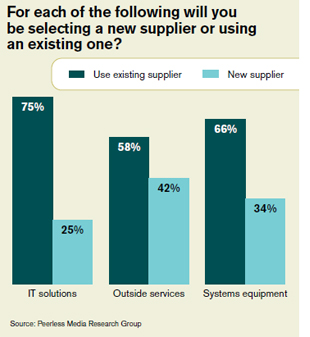 Last year Steve Banker, service director of supply chain management at ARC Advisory Group, predicted that the 2010 software market would gradually rebound and spending would increase. “If the market could grow by 1% the suppliers would be thrilled,” he said.
Last year Steve Banker, service director of supply chain management at ARC Advisory Group, predicted that the 2010 software market would gradually rebound and spending would increase. “If the market could grow by 1% the suppliers would be thrilled,” he said.
Well, suppliers should be thrilled. Banker says the industry did better than the 1% he hoped for. By the time results are in from ARC’s annual study, Banker anticipates the preliminary numbers will be good, including a 6% increase in TMS. In addition, Banker says, “WMS revenue numbers are clearly growing, and I expect the market will grow at a better than inflation rate.”
Each sector is growing at its own pace Banker says, but overall the supply chain management software market is up more than 4.5% and he expects this year’s growth to be consistent with the rate of inflation or a couple points higher.
CEMA moves forward
The Conveyor Equipment Manufacturers Association is also waiting for its 2010 year-end numbers to be finalized. In the meantime, however, CEMA executive vice president Bob Reinfried reports that last year’s prediction was off. “We were conservative for good reason, but 2010 is turning out to be a much better year for the North American conveyor market than forecasted,” he says.
Using information from CEMA’s November’s report, after 11 months, actual shipments were already up 4.4% over last year. “If December is consistent with the last two months, I would project a 10% gain in shipments for 2010,” Reinfried says.
The increase in new orders was even more significant. Through 11 months, new orders for 2010 were up 12.9% over 2009. Once again, Reinfried is conservative with his forecast. With the information currently available, his projection for the North American conveyor industry is onward and upward. “I have every reason to believe this trend will continue into 2011,” he says.
SAVE THIS IMPORTANT WEBCAST DATE | Thursday, March 31, 2011 | 1:00 p.m. EST
Join Group Editorial Director Michael Levans, Executive Editor Bob Trebilcock, and materials handling equipment consultant Don Derewecki as they go deeper into the data gleaned form the 2011 survey results while tracking changes in the material handling market over the past year.

Article Topics
Special Reports News & Resources
Automation/Retail Special Issue: Savvy users embrace change Research Report: Use of Automation in Warehouse/DC Special Digital Issue: Warehouse/DC Robotics System Report: Building the world’s best warehouse Top 20 Warehouses 2019 Top 20 automatic identification and data capture suppliers 2019 Top 20 Lift Truck Suppliers in 2019: Market reaches new heights More Special ReportsLatest in Materials Handling
Registration open for Pack Expo International 2024 Walmart chooses Swisslog AS/RS and software for third milk processing facility NetLogistik partners with Vuzix subsidiary Moviynt to offer mobility solutions for warehouses Materials Handling Robotics: The new world of heterogeneous robotic integration BSLBATT is looking for new distributors and resellers worldwide Lucas Watson appointed CSO for Körber’s Parcel Logistics business in North America Hyster recognizes Dealers of Distinction for 2023 More Materials HandlingAbout the Author
Subscribe to Materials Handling Magazine

Find out what the world's most innovative companies are doing to improve productivity in their plants and distribution centers.
Start your FREE subscription today.
April 2024 Modern Materials Handling

Latest Resources










